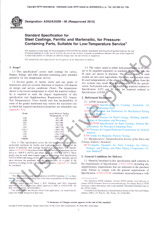We need your consent to use the individual data so that you can see information about your interests, among other things. Click "OK" to give your consent.
ASTM D7756-19
Standard Test Method for Residues in Liquefied Petroleum (LP) Gases by Gas Chromatography with Liquid, On-Column Injection
Translate name
STANDARD published on 1.5.2019
The information about the standard:
Designation standards: ASTM D7756-19
Publication date standards: 1.5.2019
SKU: NS-951560
The number of pages: 13
Approximate weight : 39 g (0.09 lbs)
Country: American technical standard
Category: Technical standards ASTM
The category - similar standards:
Annotation of standard text ASTM D7756-19 :
Keywords:
contaminants, gas chromatography, liquefied petroleum gases, LPG, mineral oil, oily residue, residue,, ICS Number Code 75.160.30 (Gaseous fuels)
Additional information
| Significance and Use | ||||||||||||||||||||||||
|
5.1 Control over the residue content as specified in Specification D1835 is of considerable importance in end-use applications of LPG. Oily residue in LPG is contamination which can occur during production, transportation, or storage. 5.2 This test method is quicker and much more sensitive than manual methods, such as Test Method D2158, which is based on evaporation of large sample volumes followed by visual or gravimetric estimation of residue content. 5.3 This test method provides enhanced sensitivity in measurements of heavier (oily) residues, with a quantification limit of 10 mg/kg total residue. 5.4 This test method gives both quantitative results and information about contaminant composition such as boiling point range and fingerprint, which can be very useful in tracing the source of a particular contaminant. |
||||||||||||||||||||||||
| 1. Scope | ||||||||||||||||||||||||
|
1.1 This test method covers the determination, by gas chromatography, of soluble hydrocarbon materials, sometimes called “oily residue,” which can be present in liquefied petroleum (LP) gases and which are substantially less volatile than the LPG product. 1.2 This test method quantifies, in the range of 10 mg/kg to 600 mg/kg (ppm mass), the residue with a boiling point between 174 °C and 522 °C (C10 to C40) in LPG. Higher boiling materials, or materials that adhere permanently to the chromatographic column, will not be detected. 1.3 Appendix X3, Appendix X4, and Appendix X6 describe additional applications which could be performed based on the hardware and procedures described in this test method. Appendix X3 describes a test procedure for expanding the analysis range to benzene, Appendix X4 describes a test procedure for the analysis of diisopropanolamine, and Appendix X6 describes a test procedure for the analysis of heavy residues or contaminants from C1.4 The values stated in SI units are to be regarded as standard. The values given in parentheses after SI units are provided for information only and are not considered standard. 1.5 This standard does not purport to address all of the safety concerns, if any, associated with its use. It is the responsibility of the user of this standard to establish appropriate safety, health, and environmental practices and determine the applicability of regulatory limitations prior to use. 1.6 This international standard was developed in accordance with internationally recognized principles on standardization established in the Decision on Principles for the Development of International Standards, Guides and Recommendations issued by the World Trade Organization Technical Barriers to Trade (TBT) Committee. |
||||||||||||||||||||||||
| 2. Referenced Documents | ||||||||||||||||||||||||
|
We recommend:
Technical standards updating
Do you want to make sure you use only the valid technical standards?
We can offer you a solution which will provide you a monthly overview concerning the updating of standards which you use.
Would you like to know more? Look at this page.




 Cookies
Cookies
